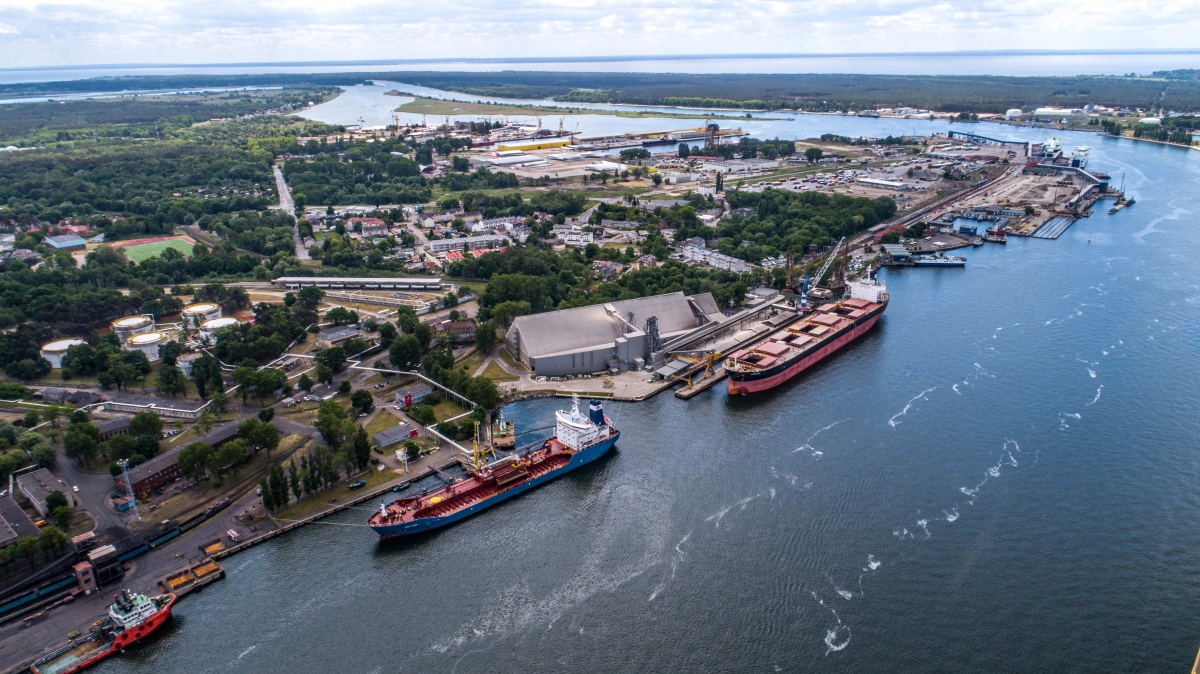
We discuss the development strategy of the Szczecin-Świnoujście port, plans for the modernization of infrastructure, and adaptation to accommodate larger vessels and service offshore wind projects with Krzysztof Urbas, the President of Szczecin and Świnoujście Seaports Authority.
Last year, the dredging of the waterway in Szczecin-Świnoujście was completed to a depth of 12.5 meters, a significant infrastructure project. What are the next stages and steps in adapting the quays and terminals of the port to accommodate larger vessels, made possible by the deepening of the waterway?
 Szczecin
and Świnoujście Seaports Authority, in order to harness the
potential of the 12.5-meter waterway to Szczecin, continues with the
following projects: improving access to the port in Szczecin in the
Kaszubski Basin area, improving access to the port in Szczecin in the
Dębicki Canal area, and the reconstruction of the Cooperative Quay
in the port of Szczecin. We will soon commence another investment
task to adapt the Zbożowe Quay to a depth of 12.5 meters. We plan to
sign a construction contract later this year, and the work will
continue until December 2024. In our long-term plans, based on the
Port Development Strategy until 2030, there is also a project to
build the Dąbrowiecki 2 Quay, along with the
immediate development of infrastructure in the Kaszubski Basin area.
Szczecin
and Świnoujście Seaports Authority, in order to harness the
potential of the 12.5-meter waterway to Szczecin, continues with the
following projects: improving access to the port in Szczecin in the
Kaszubski Basin area, improving access to the port in Szczecin in the
Dębicki Canal area, and the reconstruction of the Cooperative Quay
in the port of Szczecin. We will soon commence another investment
task to adapt the Zbożowe Quay to a depth of 12.5 meters. We plan to
sign a construction contract later this year, and the work will
continue until December 2024. In our long-term plans, based on the
Port Development Strategy until 2030, there is also a project to
build the Dąbrowiecki 2 Quay, along with the
immediate development of infrastructure in the Kaszubski Basin area.
Recently, there have been two events that significantly position the development of the Szczecin-Świnoujście port towards servicing projects related to offshore wind energy. These events include the construction of the Vestas Turbine Factory on the former ST3 Offshore site and the construction of an installation terminal by Orlen. What are the next initiatives that will help harness the momentum generated by these two projects and further utilize the port's infrastructure for expanding offshore wind farms?
Szczecin and Świnoujście Seaports Authority, in addition to the areas under the company's ownership where the Installation Terminal for Offshore Wind Farms (MFW) is being developed in cooperation with Orlen Neptun, has recently acquired neighboring land totaling approximately 26 hectares. This is in line with the adopted strategy, within which we implement the provisions of the Act on Seaports and Maritime Ports regarding real estate and areas within maritime ports. The entire area falls within the boundaries of the Maritime Port of Świnoujście, with a designated port-industrial function according to the provisions of the Local Spatial Development Plan. Additionally, as part of the shoreline/quay to be connected to the Installation Terminal, an additional 4 hectares will be reclaimed, creating a unified investment area totaling approximately 30 hectares. This substantial potential, along with the construction of necessary facilities and an additional berth for handling WTIV (Jack-up) installation vessels, will double the operational capacity of the emerging Installation Terminal (to handle 160-170 turbines annually). The new project of Szczecin and Świnoujście Seaports Authority, titled "Development of the transshipment capacity of the Świnoujście seaport for the needs of offshore wind energy – Phase II", will simultaneously and independently allow the assembly of two wind farm projects, including those in the Polish Baltic Sea. The need for this project arises from the necessity to adapt port infrastructure to the challenges of the coming decade, associated with large-scale investment projects for offshore wind energy. In June 2023, the project was submitted for revision under the National Recovery Plan (KPO) being developed by the Ministry of Finance for REPowerEU support, with a completion period until the end of 2026. Currently, Szczecin and Świnoujście Seaports Authority is in the process of preparing the Functional-Utility Program.
Due to the conflict with Russia, Ukraine has practically lost the ability to operate through its ports. Most shipowners are concerned about using these ports for transshipment. However, Ukraine has not lost its land connection with Poland. Therefore, Polish ports have taken over some of the activities that were previously carried out by Ukrainian ports, particularly concerning the export of Ukrainian goods. How does this cooperation between Poland and Ukraine manifest in Szczecin-Świnoujście?
Despite the better location of the Gdańsk and Gdynia ports, in relation to the border crossings with Ukraine and the main transportation routes, the ports of Szczecin and Świnoujście have also partially taken on the burden of exporting Ukrainian goods. Elevators located in both Szczecin and Świnoujście transshipped nearly a quarter of a million tons of Ukrainian corn and sunflower seeds, mainly to Western European countries, up until July 31, 2023. Our ports exported over 1.1 million tons of wheat (partially of Ukrainian origin) to various destinations such as Morocco, Nigeria, Spain, Germany, Guinea, South Africa, Tanzania, Congo, Liberia and Madagascar from March 2022 to July 2023 (since the outbreak of the war). Ukrainian goods are not limited to grains; we have also handled iron ore concentrate produced in ArcelorMittal facilities in Kryvyi Rih, amounting to over 670,000 tons. Additionally, we handle other Ukrainian products such as steel products and various general cargo. Interestingly, we are also transit ports for goods being imported into Ukraine. We have served, for example, two large LNG tankers on the L. Kaczyński Terminal, which carried liquefied natural gas for the Ukrainian economy, as well as ships carrying coal that was later delivered to Ukraine.
The construction of a deep-water container terminal in Świnoujście is gaining momentum. How do you see this terminal expanding, and how will it impact the activities of the Szczecin-Świnoujście port? Is there a plan for a holistic vision of cooperation among various container terminals in Polish ports to avoid competition between the terminals in the Tri-City area and Świnoujście, and achieve a synergistic effect that enhances the quality of service for container carriers?
The Deep-Water Container Terminal in Świnoujście is a strategic development project led by Szczecin and Świnoujście Seaports Authority. The establishment of the deep-water container terminal will primarily enable better utilization of the port's potential in Świnoujście. The significant strength of this project is its location. Świnoujście's proximity to the Danish Straits facilitates and reduces the costs of operations for oceanic vessels in the Baltic Sea. The port's location also provides easy access to southwestern Poland and eastern Germany and the Baltic-Adriatic corridor, connecting Slovakia, the Czech Republic, Austria, and even Hungary and the countries bordering the Adriatic Sea. The ports of Szczecin and Świnoujście are on the primary route from Scandinavia to southern Europe. Moreover, the port of Świnoujście is listed both in the core network of TEN-T maritime ports and inland waterways, thanks to its connection to the Odra River Waterway and the Western European waterway system.
Regarding the connection of the port to the hinterland, it is essential to mention the railway and road infrastructure. Substantial investments in the railway infrastructure of the Szczecin and Świnoujście ports, amounting to around 1.5 billion PLN, have been carried out with the aim of improving the connection between the port's railway system and the national railway network. The future terminal will be connected to the national railway transport system via the international railway mainline E59/C-E59. The S3 expressway will soon fully connect the ports of Szczecin and Świnoujście to the highway and expressway network in Poland and Central Europe. The modernization of the S10 expressway is also underway. All these investments will be completed before the planned launch of the deep-water container terminal in Świnoujście.
The Baltic Sea, with its many surrounding countries and relatively small size, is an excellent location for ferry connections between different countries. Polish ferry operators are currently expanding their fleets. Foreign ferry operators are also coming to Świnoujście with their connections. What prospects do you see for expanding the ferry network, and are there discussions about new destinations and routes, perhaps even in light of the conflict in Ukraine and the isolation of the Kaliningrad region? Is the Baltic Sea highway waiting to be developed?
Indeed, the Baltic Sea is an excellent location for ferry navigation, as exemplified by the Ferry Terminal located in Świnoujście. The terminal handles up to 13 arrivals per day and 78 arrivals per week, making it a key element of the virtual bridge - the maritime highway between continental Europe and Scandinavia. Świnoujście maintains connections with Trelleborg and Ystad. This direction (southern Baltic/Scandinavia) is the primary focus for Szczecin and Świnoujście Seaports Authority. The authority is responsible for the terminal's infrastructure, and continuous development is aimed at creating the best conditions for operators using the terminal while constantly expanding the infrastructure. The modernization of the terminal to accommodate the largest ferries and enable intermodal transport is currently in completion. The investment is planned to be made available to ferry and railway operators in October 2023. It is important to note that having the right infrastructure is not a sufficient condition to open a new ferry line. The creation of new connections is the responsibility of ferry operators, who, based on market analysis, cargo flows, and their customers' needs, decide on the possible opening of new routes, always taking into account the profitability of the undertaking. Szczecin and Świnoujście Seaports Authority engages in discussions with ferry operators, presenting new possibilities, but the final decision is always in the hands of the transport operator.
Indeed, the conflict in Ukraine presents potential opportunities for opening new parallel connections. However, it should be noted that establishing and developing a profitable new route takes years. Therefore, building a business plan based on variables and crisis conditions would entail significant risks for ferry operators. The port authority has been working on the idea of a connection between Świnoujście and Klaipėda for many years. Market analyses conducted by potentially involved parties, such as Szczecin and Świnoujście Seaports Authority, ferry operators and road carriers, have indicated insufficient profitability and potential for opening such a connection. Previous discussions with ferry operators have confirmed the sporadic and irregular flow of cargo on this route, and the interest from transport and forwarding companies is insufficient to ensure the profitability of this endeavor. Flexible road transport is generally favored, which further benefits from the continuous modernization of railway and road infrastructure. It is also worth noting the existing routes to Rostock and Travemünde and, most importantly, the fact that one of the ferry operators already offers an indirect Świnoujście-Klaipėda connection via the port of Trelleborg. If there is demand for such a connection from the ferry market, we are ready to start servicing vessels to support such new destinations. We once again emphasize the full readiness of our infrastructure to handle an increased number of connections.


